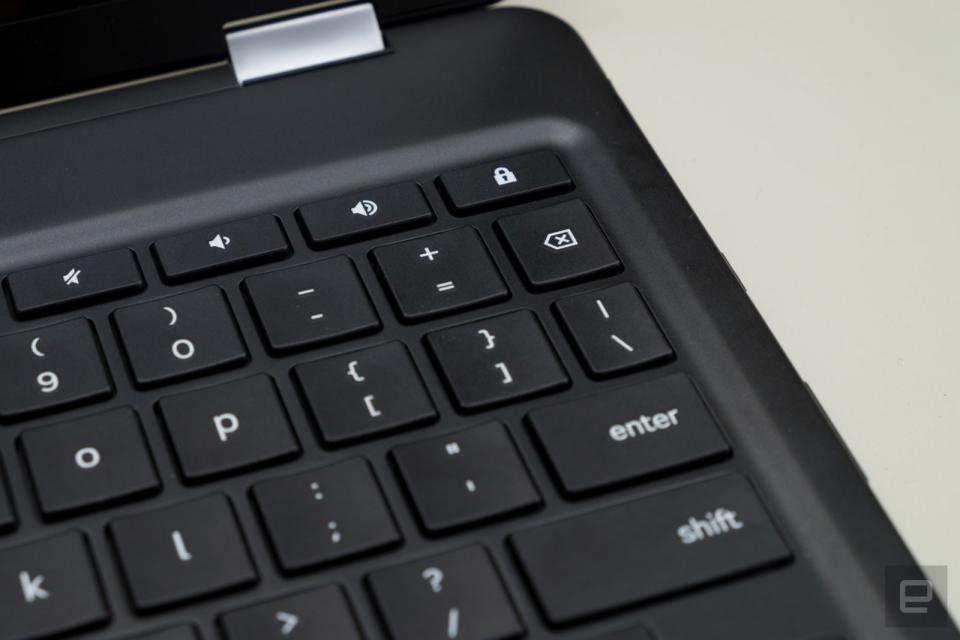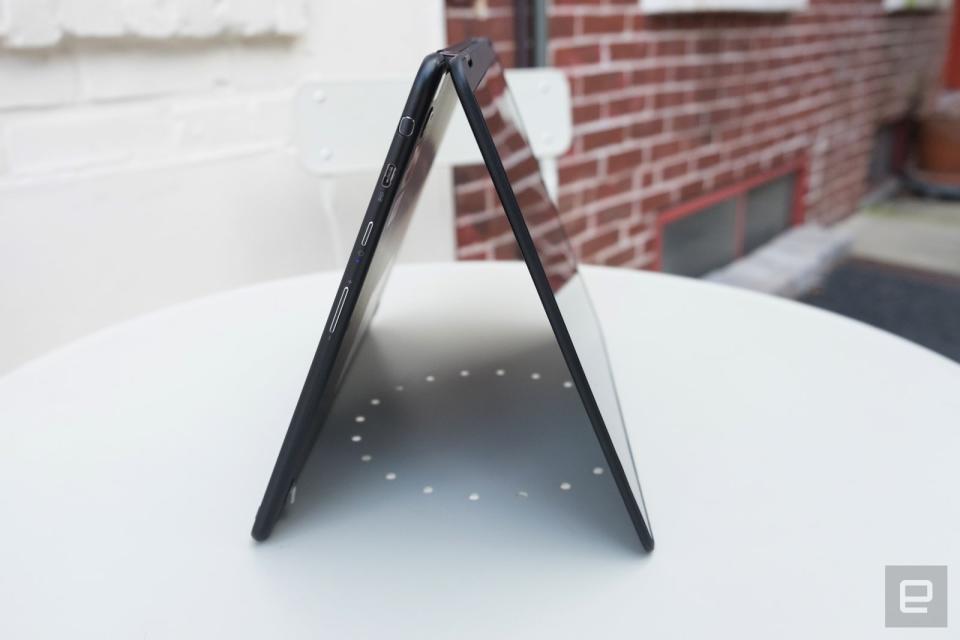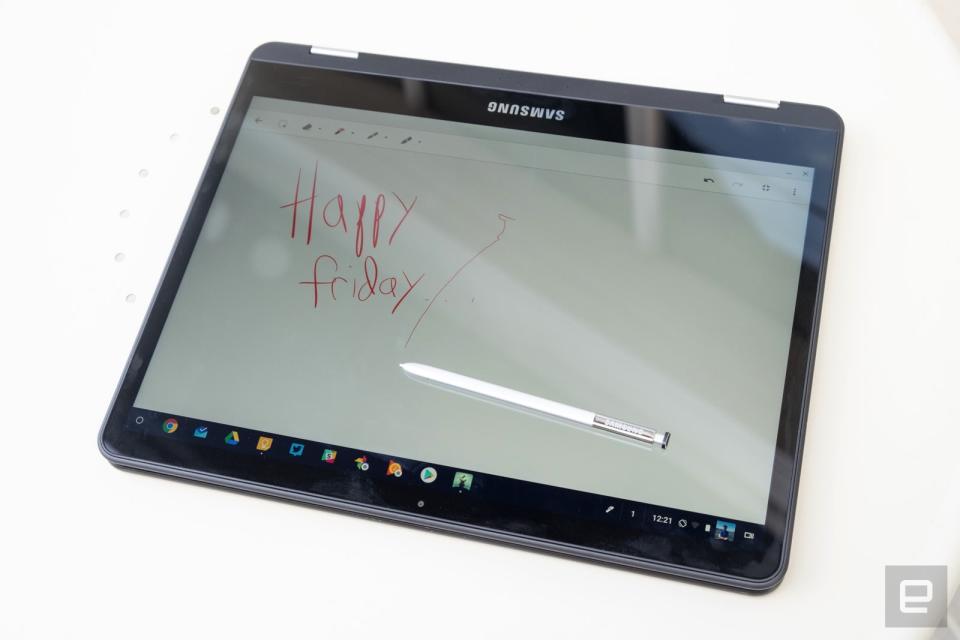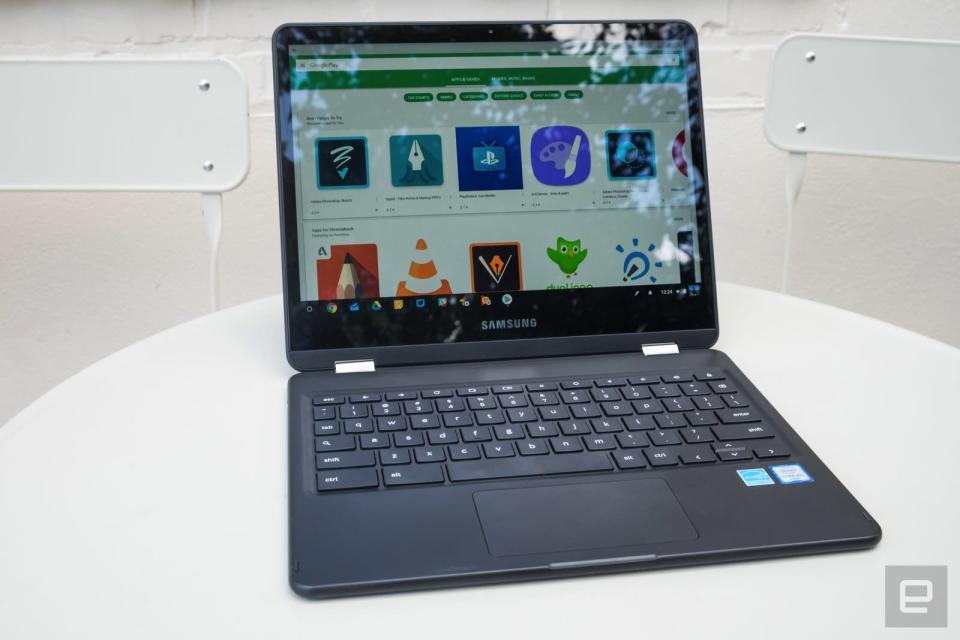Samsung Chromebook Pro review: One misstep spoils the show
It's close to the ideal Chromebook, but only if you don't value battery life.

My co-workers mercilessly chide me every time I review a Chromebook. "They're all the same!" they laugh. I then patiently explain the many variations on the Chromebook formula that exist. From no-frills $200 bricks with lousy screens that simply get you online to premium laptops with great design that cost nearly as much as a good Windows machine -- there's actually a pretty wide variety of Chromebooks out there.
However, in the case of Samsung's Chromebook Pro, the sales pitch is basically identical to the ASUS Chromebook Flip, which I reviewed last month. It's a well-built laptop that feels much more expensive than its $550 price, it has a great screen that flips around so you can use it as a tablet and it's one of a few Chromebooks that supports Android apps from the Google Play Store.
I tried a preproduction version of the laptop back in February and found it lacking on a few fronts. Then, the final hardware was a bit delayed, and I experienced some rather notable bugs. But with those launch troubles in the rearview mirror, I've settled in with the final hardware to see if it can match the expectations I had back in January with the Chromebook Pro was first announced.
Hardware
The Chromebook Pro isn't a huge innovator in terms of design, but it has a lot of thoughtful touches that separate it from the rest of the market. First up, I was struck by the all-black metallic design. It simply looks great, and there aren't a whole lot of other laptops out there that give off quite the same aura. It's also quite small, light and thin, if not very flashy. The two halves of the laptop are both rounded off, which makes it look a bit like a sandwich when closed; there's an impression of two tablets lying on top of each other, almost. I don't mind the aesthetic at all; it's just a bit different than the usual one-piece feel you get when most laptops are closed.
Opening up the Pro shows off black keys against a black body, unmarred except for the tiny. annoying stickers that we seemingly will never get away from. Then, the display lights up, and what a display it is. The 2,400 x 1,600 screen is bright, sharp, colorful and has great viewing angles. It's probably the best you'll find on any Chromebook outside the now-discontinued Pixel. Like the Pixel, it's a touchscreen, and it's also in a 3:2 aspect ratio (rather than the 16:9 that's standard on most laptops). That means you have more vertical area when scrolling through documents and web pages, though you'll see larger black bars when watching video. Overall, I prefer the tradeoff and really wish more manufacturers made screens this size.
The aspect ratio also works well when you use the Chromebook Pro's 360-degree hinge to flip the computer into tablet mode. Because it's slightly more square, it work well in both portrait and landscape mode. Unlike the ASUS Chromebook Flip, the Pro is also light enough to make using it as a tablet ever-so-slightly more feasible. But, at 2.4 pounds, it's still far heavier than an iPad or Surface, and I didn't find myself using it like this for very long.

The keyboard is good, but unfortunately not quite as good as the one on the Chromebook Flip. It's not backlit, for starters, and the narrower frame means that everything feels just a little too cramped. That's not to say you can't adjust; I can type quite fast on it, and the key travel is solid for such a thin machine. But the Flip's keyboard is definitely more comfortable, backlit and generally doesn't make any compromises. On the other hand, look at the ridiculous "delete" key on the Pro and know that you'll spend a lot of time missing that target -- something you'll definitely want to keep in mind if you buy this machine. The trackpad is totally fine; it's a little small and wide compared to what I'm used to on my MacBook Air, but it's pretty standard-issue for Chromebooks.
Finally, around the edges of the Chromebook Pro you'll find two USB-C ports (one on each side), a headphone jack, the power button, a volume rocker and a slot that hides Samsung's S Pen stylus -- more on that later. The Pro's speakers are actually on the bottom; that makes sense given the computer's convertible nature. Firing audio up from the keyboard area wouldn't work very well when using the computer in tablet or "tent" mode, after all. But the downward-facing speakers sound pretty terrible in laptop mode unless you place the Pro on a hard surface like a desk. If it's, well, in your lap, audio is very muffled. It's good enough for a video call, but you won't want to listen to music or watch a movie like this. Just use headphones.
Performance and battery life

The Chromebook Pro comes with internals that I consider to be standard-issue for such a computer at this point. That includes an Intel Core m3-6Y30 processor, 4GB of RAM and 32GB of internal storage. I wish Samsung had sprung for 64GB -- with Android apps, you'll be downloading a lot more to your local storage, both in terms of the apps themselves as well as content to enjoy when you're offline.
That quibble aside, the Chromebook Pro typically does what I need it to. That is, it runs multiple Chrome windows, with many tabs, smoothly while also handling standalone Chrome apps for Todoist, Keep, Hangouts, Google Play Music, Slack and Tweetdeck (though not usually all of those at once). I also took the occasional video call in Hangouts, it worked with no problems; the 720p video camera is nothing special but got the job done fine. Occasionally, things would stutter or slow down a bit, but I had to push pretty hard for this to be the case. Adding in Android apps would also slow things down -- I found that those apps were best used one at a time, in full-screen mode.
Unfortunately, the Chromebook Pro has a major Achilles' heel: battery life. While it lasted about seven hours in our battery test (which loops HD video at 66 percent brightness), I only got between four and five hours while using the Pro as outlined above. That was a serious disappointment for a device meant to be used on the go. Maybe I'm expecting more than I should from a $550 computer, which is high for a Chromebook but still on the lower end of the laptop market. But I personally wouldn't shell out for a computer with that limited of a lifespan. Unfortunately, most Chromebooks I've tried lately have had strangely weak battery life. At least the ASUS Chromebook Flip consistently more than six hours of battery. That's not great, but it's an improvement. If your workflow means you're usually near a power outlet or you don't mind carrying a charger around, the Pro will get the job done. Users who crave long battery life should keep looking, however.
Software

The Pro is Samsung's first Chromebook that includes an S Pen for taking notes and sketching and other stylus-driven features. Samsung helpfully included a little custom software to make the pen more useful right out of the box. When you pop it out of its convenient slot in the side of the laptop, a dialog box with a few pen-focused options appears. Most useful of those is probably a one-tap shortcut to Google Keep; the app opens right up with a new page ready for you to draw or write all over. Naturally, this feature is most useful in tablet mode, where you can use the Pro like a giant notebook.
Google's handwriting recognition means these notes you write out are searchable in Keep alongside your typed ones, which definitely makes the feature more useful. Unfortunately, I've noticed a lot of lag when writing in Keep -- it feels far more sluggish than on the iPad Pro with the Apple pencil or the Surface Pro and its pen. That's surprising because Google said when the Pro was first announced that it was implementing machine learning technology to analyze what you're writing to predict the letters and words you were forming.
That was supposed to reduce latency and actually improve the quality of your handwriting. But I haven't seen any evidence that this feature is actually active; if it is, it's not doing much good. A Google spokesperson said that the team is working to improve latency and prediction capabilities, but I get the sense that it's not the experience the company was shooting for when the Pro was announced.
Other stylus shortcuts include one-tap screenshot capture; you can also use the pen to outline the area you want to grab. From there, you can use the pen to annotate the screenshot and save it into Keep or share it out. Windows 10 lets you do something similar, as will iOS 11 on the iPad when it launches. I didn't really see the utility of this at first, but it's actually a very handy way to give suggestions when editing a web layout, for example. It's like leaving comments and suggestions on a text document, but you can do it on any screen of your computer.

You can also use the stylus to interact with basically any on-screen elements if you so choose, which means you can draw in the many different sketching apps out there in the Google Play Store. I can't draw to save my life, but the Samsung ArtCanvas app that comes included on the Chromebook Pro seems to work well with the stylus. It's pressure-sensitive, which means you can get more precision and variability in your pen strokes as you draw. Latency is still an issue, but budding artists working on a budget might want to give this computer a shot as a first digital canvas.
As mentioned, the Chromebook Pro can run the Google Play Store and Android apps. One of the things I had a hard time figuring out when I first tested the Pro was when to opt for Android apps over web counterparts. What I've settled on is that usually web versions are best, but Android apps are better if you need to save things offline. That means that Android apps are usually for specific tasks or situations rather than things you run all the time. But that doesn't mean they aren't quite useful when you do need them. For more on the current state of Android on Chromebooks, check out the software section in my review of the Chromebook Flip from a few weeks ago. Basically, everything I said there applies to the Pro, as well.
The competition

The Chromebook Pro's main competition comes from Samsung itself in the form of the Chromebook Plus. It's $100 cheaper, has a silver finish instead of black and runs on an ARM-based chip called the OP1 rather than the Intel processor in the Pro. I haven't personally tested out the Plus yet, but other reviews suggest that the processor can be a bit of a dog if you push it too hard. That said, it does appear to run Android apps well; if your needs are pretty basic, it might be worth a look.
Meanwhile, the ASUS Chromebook Flip, as I've mentioned, is a near-direct competitor to the Pro. They have very similar hardware, design and features -- the Flip includes 64GB of storage to the Pro's 32GB. It also has a backlit keyboard that's a good deal more comfortable to use, and its battery life is better (but still not great). The Pro counters with S Pen support and one of the best screens you can find on a Chromebook. But the Flip is priced at $480, compared to the $550 Pro. At that price, the Flip makes a very compelling argument for choosing it over Samsung's latest Chromebook.
Wrap-up

After testing the Chromebook Pro, I had to admit that it's not the king of the Chromebooks I was hoping for when it was first announced. It does plenty of things well -- I love its looks, screen and performance, but the keyboard's a bit cramped and the S Pen is a mixed bag. Much more important, though, is the fact that its battery life just isn't good enough in comparison to other options out there on the market. Samsung is very close to a formula that works here, but it's not quite there yet. If Samsung builds a Chromebook Pro that gets seven hours of battery life, I'd call it the best Chromebook out there. Unfortunately for Samsung, ASUS has already done that.
If you're the type of user who is more interested in a great display or S Pen support, the Pro is definitely worth a look. It can do double duty as a stylus-driven tablet and a solid laptop better than the Chromebook Flip. But for the average computer user who wants a comfortable laptop that can last all day, the Pro comes up just a little short.













